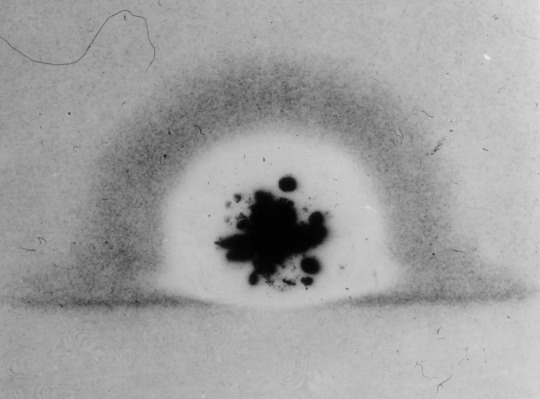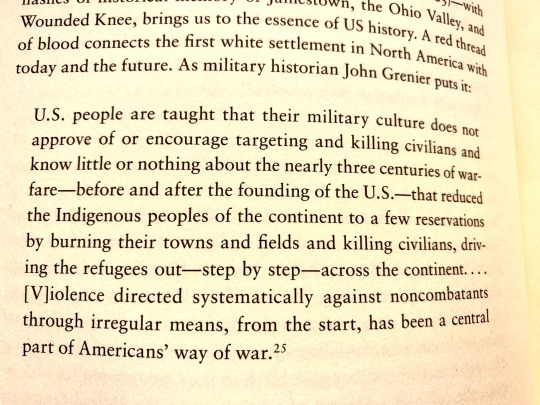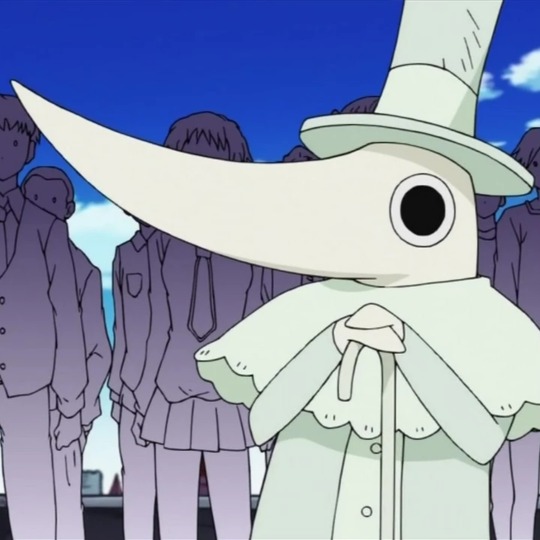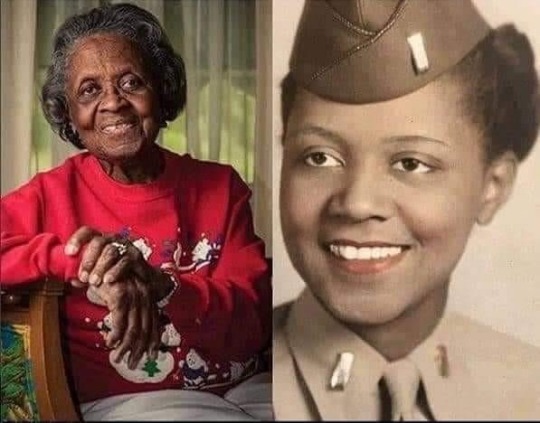#US 🇺🇸
Text
The First Light of Trinity
— By Alex Wellerstein | July 16, 2015 | Annals of Technology

Seventy years ago, the flash of a nuclear bomb illuminated the skies over Alamogordo, New Mexico. Courtesy Los Alamos National Laboratory
The light of a nuclear explosion is unlike anything else on Earth. This is because the heat of a nuclear explosion is unlike anything else on Earth. Seventy years ago today, when the first atomic weapon was tested, they called its light cosmic. Where else, except in the interiors of stars, do the temperatures reach into the tens of millions of degrees? It is that blistering radiation, released in a reaction that takes about a millionth of a second to complete, that makes the light so unearthly, that gives it the strength to burn through photographic paper and wound human eyes. The heat is such that the air around it becomes luminous and incandescent and then opaque; for a moment, the brightness hides itself. Then the air expands outward, shedding its energy at the speed of sound—the blast wave that destroys houses, hospitals, schools, cities.
The test was given the evocative code name of Trinity, although no one seems to know precisely why. One theory is that J. Robert Oppenheimer, the head of the U.S. government’s laboratory in Los Alamos, New Mexico, and the director of science for the Manhattan Project, which designed and built the bomb, chose the name as an allusion to the poetry of John Donne. Oppenheimer’s former mistress, Jean Tatlock, a student at the University of California, Berkeley, when he was a professor there, had introduced him to Donne’s work before she committed suicide, in early 1944. But Oppenheimer later claimed not to recall where the name came from.
The operation was designated as top secret, which was a problem, since the whole point was to create an explosion that could be heard for a hundred miles around and seen for two hundred. How to keep such a spectacle under wraps? Oppenheimer and his colleagues considered several sites, including a patch of desert around two hundred miles east of Los Angeles, an island eighty miles southwest of Santa Monica, and a series of sand bars ten miles off the Texas coast. Eventually, they chose a place much closer to home, near Alamogordo, New Mexico, on an Army Air Forces bombing range in a valley called the Jornada del Muerto (“Journey of the Dead Man,” an indication of its unforgiving landscape). Freshwater had to be driven in, seven hundred gallons at a time, from a town forty miles away. To wire the site for a telephone connection required laying four miles of cable. The most expensive single line item in the budget was for the construction of bomb-proof shelters, which would protect some of the more than two hundred and fifty observers of the test.
The area immediately around the bombing range was sparsely populated but not by any means barren. It was within two hundred miles of Albuquerque, Santa Fe, and El Paso. The nearest town of more than fifty people was fewer than thirty miles away, and the nearest occupied ranch was only twelve miles away—long distances for a person, but not for light or a radioactive cloud. (One of Trinity’s more unusual financial appropriations, later on, was for the acquisition of several dozen head of cattle that had had their hair discolored by the explosion.) The Army made preparations to impose martial law after the test if necessary, keeping a military force of a hundred and sixty men on hand to manage any evacuations. Photographic film, sensitive to radioactivity, was stowed in nearby towns, to provide “medical legal” evidence of contamination in the future. Seismographs in Tucson, Denver, and Chihuahua, Mexico, would reveal how far away the explosion could be detected.

The Trinity test weapon. Courtesy Los Alamos National Laboratory
On July 16, 1945, the planned date of the test, the weather was poor. Thunderstorms were moving through the area, raising the twin hazards of electricity and rain. The test weapon, known euphemistically as the gadget, was mounted inside a shack atop a hundred-foot steel tower. It was a Frankenstein’s monster of wires, screws, switches, high explosives, radioactive materials, and diagnostic devices, and was crude enough that it could be tripped by a passing storm. (This had already happened once, with a model of the bomb’s electrical system.) Rain, or even too many clouds, could cause other problems—a spontaneous radioactive thunderstorm after detonation, unpredictable magnifications of the blast wave off a layer of warm air. It was later calculated that, even without the possibility of mechanical or electrical failure, there was still more than a one-in-ten chance of the gadget failing to perform optimally.
The scientists were prepared to cancel the test and wait for better weather when, at five in the morning, conditions began to improve. At five-ten, they announced that the test was going forward. At five-twenty-five, a rocket near the tower was shot into the sky—the five-minute warning. Another went up at five-twenty-nine. Forty-five seconds before zero hour, a switch was thrown in the control bunker, starting an automated timer. Just before five-thirty, an electrical pulse ran the five and a half miles across the desert from the bunker to the tower, up into the firing unit of the bomb. Within a hundred millionths of a second, a series of thirty-two charges went off around the device’s core, compressing the sphere of plutonium inside from about the size of an orange to that of a lime. Then the gadget exploded.
General Thomas Farrell, the deputy commander of the Manhattan Project, was in the control bunker with Oppenheimer when the blast went off. “The whole country was lighted by a searing light with the intensity many times that of the midday sun,” he wrote immediately afterward. “It was golden, purple, violet, gray, and blue. It lighted every peak, crevasse, and ridge of the nearby mountain range with a clarity and beauty that cannot be described but must be seen to be imagined. It was that beauty the great poets dream about but describe most poorly and inadequately.” Twenty-seven miles away from the tower, the Berkeley physicist and Nobel Prize winner Ernest O. Lawrence was stepping out of a car. “Just as I put my foot on the ground I was enveloped with a warm brilliant yellow white light—from darkness to brilliant sunshine in an instant,” he wrote. James Conant, the president of Harvard University, was watching from the V.I.P. viewing spot, ten miles from the tower. “The enormity of the light and its length quite stunned me,” he wrote. “The whole sky suddenly full of white light like the end of the world.”

In its first milliseconds, the Trinity fireball burned through photographic film. Courtesy National Archives and Records Administration
Trinity was filmed exclusively in black and white and without audio. In the main footage of the explosion, the fireball rises out of the frame before the cameraman, dazed by the sight, pans upward to follow it. The written accounts of the test, of which there are many, grapple with how to describe an experience for which no terminology had yet been invented. Some eventually settle on what would become the standard lexicon. Luis Alvarez, a physicist and future participant in the Hiroshima bombing, viewed Trinity from the air. He likened the debris cloud, which rose to a height of some thirty thousand feet in ten minutes, to “a parachute which was being blown up by a large electric fan,” noting that it “had very much the appearance of a large mushroom.” Charles Thomas, the vice-president of Monsanto, a major Manhattan Project contractor, observed the same. “It looked like a giant mushroom; the stalk was the thousands of tons of sand being sucked up by the explosion; the top of the mushroom was a flowering ball of fire,” he wrote. “It resembled a giant brain the convolutions of which were constantly changing.”
In the months before the test, the Manhattan Project scientists had estimated that their bomb would yield the equivalent of between seven hundred and five thousand tons of TNT. As it turned out, the detonation force was equal to about twenty thousand tons of TNT—four times larger than the expected maximum. The light was visible as far away as Amarillo, Texas, more than two hundred and eighty miles to the east, on the other side of a mountain range. Windows were reported broken in Silver City, New Mexico, some hundred and eighty miles to the southwest. Here, again, the written accounts converge. Thomas: “It is safe to say that nothing as terrible has been made by man before.” Lawrence: “There was restrained applause, but more a hushed murmuring bordering on reverence.” Farrell: “The strong, sustained, awesome roar … warned of doomsday and made us feel that we puny things were blasphemous.” Nevertheless, the plainclothes military police who were stationed in nearby towns reported that those who saw the light seemed to accept the government’s explanation, which was that an ammunition dump had exploded.
Trinity was only the first nuclear detonation of the summer of 1945. Two more followed, in early August, over Hiroshima and Nagasaki, killing as many as a quarter of a million people. By October, Norris Bradbury, the new director of Los Alamos, had proposed that the United States conduct “subsequent Trinity’s.” There was more to learn about the bomb, he argued, in a memo to the new coördinating council for the lab, and without the immediate pressure of making a weapon for war, “another TR might even be FUN.” A year after the test at Alamogordo, new ones began, at Bikini Atoll, in the Marshall Islands. They were not given literary names. Able, Baker, and Charlie were slated for 1946; X-ray, Yoke, and Zebra were slated for 1948. These were letters in the military radio alphabet—a clarification of who was really the master of the bomb.

Irradiated Kodak X-ray film. Courtesy National Archives and Records Administration
By 1992, the U.S. government had conducted more than a thousand nuclear tests, and other nations—China, France, the United Kingdom, and the Soviet Union—had joined in the frenzy. The last aboveground detonation took place over Lop Nur, a dried-up salt lake in northwestern China, in 1980. We are some years away, in other words, from the day when no living person will have seen that unearthly light firsthand. But Trinity left secondhand signs behind. Because the gadget exploded so close to the ground, the fireball sucked up dirt and debris. Some of it melted and settled back down, cooling into a radioactive green glass that was dubbed Trinitite, and some of it floated away. A minute quantity of the dust ended up in a river about a thousand miles east of Alamogordo, where, in early August, 1945, it was taken up into a paper mill that manufactured strawboard for Eastman Kodak. The strawboard was used to pack some of the company’s industrial X-ray film, which, when it was developed, was mottled with dark blotches and pinpoint stars—the final exposure of the first light of the nuclear age.
#Hiroshima | Japan 🇯🇵 | John Donne | Manhattan Project | Monsanto#Nagasaki | Japan 🇯🇵 | Nuclear Weapons | Second World War | World War II#The New Yorker#Alex Wellerstein#Los Alamos National Laboratory#New Mexico#J. Robert Oppenheimer#John Donne#Jean Tatlock#University of California Berkeley#Jornada del Muerto | Journey of the Dead Man#General Thomas Farrell#Nobel Prize Winner Physicist Ernest O. Lawrence#Luis Alvarez#US 🇺🇸#China 🇨🇳#France 🇫🇷#Soviet Union (Now Russia 🇷🇺)#Alamogordo | New Mexico#Eastman Kodak#Nuclear Age
38 notes
·
View notes
Text

“U.S. people are taught that their military culture does not approve of or encourage targeting and killing civilians and know little or nothing about the nearly three centuries of war-fare-before and after the founding of the U.S.-that reduced the Indigenous peoples of the continent to a few reservations by burning their towns and fields and killing civilians, driving the refugees out--step by step--across the continent....Violence directed systematically against noncombatants through irregular means, from the start, has been a central part of Americans' way of war. “
Military Historian John Grenier
#us history#wounded knee#sand creek#trail of tears#the long walk#bear river#thanks taking#in Country#🇺🇸#land back#crazy horse#tecumseh#sitting bull#Geronimo#chief joseph#emiliano zapata#Joaquin murrieta#Pó Pay#captain Jack#war crimes
150 notes
·
View notes
Text
US of Genocides🇺🇸

US of Genocides🇺🇸
US of Genocides🇺🇸
US of Genocides🇺🇸
#US of Genocides🇺🇸#palestine#gazaunderattack#gaza#free palestine#gaza hospital#israel is a terrorist state#غزة تحت القصف#فلسطين
22 notes
·
View notes
Text
not to be antiamerican but on god i'll live to see the day the US' empire falls still in my lifetime 🙏
#the UN decision has me fucking LIVID#if you haven't been following the news: brazil drafted a solution for the humanitarian crisis in gaza#12 countries voted in agreement 🇨🇳 🇫🇷 🇦🇱 🇧🇷 🇪🇨 🇬🇦 🇬🇭 🇯🇵 🇲🇹 🇲🇿 🇨🇭 🇦🇪#2 abstained 🇬🇧 🇷🇺#and ONE. ONE VOTED AGAINST 🇺🇸#and because that ONE vote for some reason matters more than 12 otehr votes#the solution won't be passed#i'm so fucking mad. UN is such a joke. the US is such a joke. every empire falls and i will live to see the day the US does#im so tired#if you havent gotten it this is a pro-palestine blog. my mind will not be changed. just get out of here if you are not
49 notes
·
View notes
Text

this bitch
#it's blurry because i screenshotted it on my laptop but like...#MUSCULAR AND STRONG 🔥🔥 WHITE 🇺🇸🦅🍻🏈 DEEP VOICE 🔥🗣#gaslight gatekeep girlblog#girlblogging#this is a girlblog#just girly things#hell is a teenage girl#this is what makes us girls#im gonna cry#kms
18 notes
·
View notes
Text
Joel Miller from The Last Of Us shares a voice actor with Excalibur from Soul Eater.
Voiced by Troy Baker


#same voice actor#voice acting#submission#the last of us#the last of us part 2#soul eater#playstation#sony computer entertainment#naughty dog#crunchyroll#studio bones#square enix#🇺🇸
14 notes
·
View notes
Text
I love saying “it’s my God given right as an American” about the lamest things. Just dismissed a spellcheck suggestion and said “it’s my God given right as an American to spell words however I damn well please”
#which is funnier to me imo bc I use 🇬🇧 English as opposed to 🇺🇸 English in writing#American hubris only hits when I’m doing the most mundane things#big fan of dying on unserious hills#moose rambles#moose posting
20 notes
·
View notes
Text

Honoring the 1st US Army Black Female Pilot - Millie Bailey. She served in WWII and was 104 years old when she passed away in May of 2022.
#milliebaily#blackhistory#1rstarmyblackfemalepilot#blackfemalepilots#female pilots#104yearsold#us army#🇺🇸🇺🇸🇺🇸#rip🤍#ww2
51 notes
·
View notes
Text


#f1#logan sargeant#still funnier to think he doesn’t even tho is whole career has been in Europe#us gp 2023#austin gp 2023#🇺🇸🦅
17 notes
·
View notes
Text
i want logan sergeant to get points at sliverstone for only reason that it'll be funny. i want him to get his first points on july 4 weekend on britian and celebrate by dumping more tea in the habor.
#f1#formual one#logan sargeant#williams formula 1#raawr usa usa usa#americA#my pronouns are usa#type beat#logan is gonna wins us the revolutionary war pt 2#it just amuses me#*general eagle noises*#logan sergeant is my fav miami frat boy#i hope he was able to play beer pong today#f1 fandom#formula 2#4th of july#WTF IS A KILOMETER 🦅🦅🇺🇸🇺🇸🇵🇷🎊🎆🎆#🏎️💨#frat boi logan agenda
49 notes
·
View notes
Text
Biased Reporting
— Vitaly Podvitski | October 13, 2023

Cartoon: Vitaly Podvitski
Losing Steam
— Chen Xia | October 12, 2023

Illustration: Liu Rui/Global Times
#China 🇨🇳#US 🇺🇸#Forever Palestine 🇵🇸#Illegal Regime of Isra-hell 🇮🇱#US Economy | Debt Crisis | Inflation | Strikes#Cartoons#Vitaly Podvitski#Chen Xia
2 notes
·
View notes
Text
Whoooooo gave them the RIGHT to be so fucking CUTE
#it's the 'long time no seeee!'#and the 'oh and i told my sister!' 'oh! i didn’t know that!' 'yeah she's really happy for us 😇'#for me 💕#they picked amazing actors for these roles i cannot hecking wait to see this movie#red white & royal blue#rwrb#red white & royal blue movie#movie adaptation#queer movie#queer books#fsotus alexander claremont diaz#prince henry fox mountchristen windsor#alex x henry#firstprince#taylor zakhar perez#nicholas galitzine#films#movies#books to movies#🇬🇧🩷🇺🇸
21 notes
·
View notes
Text
XOXO<33


You get a no shawl version and a shawl version also more suggestive version below its the same but with lipstick marks


They’re so cute I’m gonna explode
#lisa the painful#lisa rpg#crisp ladaddy#toby lisa rpg#suggestive cw#cw suggestive#MEN USED TO GO WAR 🇺🇸🦅💥🦅🇺🇸🦅💥🦅🦅🦅💥#why is he grabbing men by the hip and waist? is he gay? /j#forcing the crisptoby agenda down everyone’s throats#crisp x toby
18 notes
·
View notes
Text
today ain’t a good day for the americans 🤠
#solreacting#formula 1#f1#us gp 2023#both haas AND logan out in sq1?#not very 🦅🇺🇸💥 of them#logan sargeant#kevin magnussen#nico hulkenberg
10 notes
·
View notes
Note
🌴🌿🦥🦜🌊🐟🐟🐠🌿🌴
nature is beautiful
( - @felpsederation )
you know you’re right man. scary as fuck but it’s nice to be apart of i guess 🦖
#we haven’t talked a lot. we should go on a fucking#like a walk or something#since you mentioned nature. i’m calling you the nature guy now#partner applications#you copied me! 🇺🇸#the first of us
7 notes
·
View notes
Text

LETSGOOOOOOOO
8 notes
·
View notes